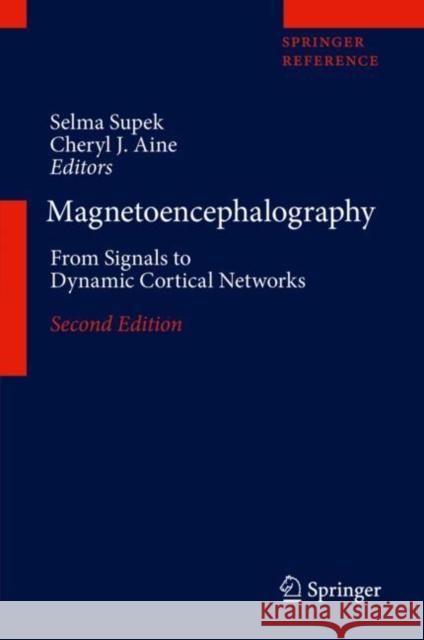Magnetoencephalography: From Signals to Dynamic Cortical Networks » książka



Magnetoencephalography: From Signals to Dynamic Cortical Networks
ISBN-13: 9783030000868 / Angielski / Twarda / 2019 / 1430 str.
Magnetoencephalography: From Signals to Dynamic Cortical Networks
ISBN-13: 9783030000868 / Angielski / Twarda / 2019 / 1430 str.
(netto: 2198,06 VAT: 5%)
Najniższa cena z 30 dni: 2297,25 zł
ok. 20 dni roboczych.
Darmowa dostawa!
This book surveys MEG basics and covers the latest methodological, empirical and clinical research. Includes tutorials on instrumentation, measurement, modeling and experimental design, discussion of open issues, future developments and new applications.
MEG as an Enabling Tool in Neuroscience - Transcending Boundaries with New Analysis Methods and Devices
Instrumentation for Measuring MEG Signals
Novel Noise Reduction Methods
Electric and Magnetic Fields of the Brain
Forward Modeling and Tissue Conductivities
EEG/MEG Source Estimation and Spatial Filtering: The Linear Toolkit
Designing MEG Experiments
Magnetoencephalographic Imaging
MEG and Multimodal Integration
Simultaneous recordings of MEG and intracerebral EEG
Fusing Concurrent EEG and fMRI Intrinsic Networks
Nonparametric Statistical Analysis of Map Topographies on the Epoch LevelDual Signal Subspace Projection (DSSP): A Powerful Algorithm for Interference Removal and Selective Detection of Deep Sources
MNE: Software for Acquiring, Processing,and Visualizing MEG/EEG Data
MRIVIEW: A Software Package for the Analysis and Visualization of Brain Imaging Data
MEG/EEG Data Analysis Using EEGLAB
MEG-SIM Web Portal: A Database of Realistic Simulated and Empirical MEG Data for Testing Algorithms
An Introduction to MEG Connectivity Measurements
Human Brain Oscillations: From Physiological Mechanisms to Analysis and Cognition
Studying Dynamic Neural Interactions with MEG
Unified Principles of Thalamocortical Network Dynamics: A Framework for Typical/Atypical Functional ConnectivityTemporal and Spectral Signatures of the Default Mode Network
Methods to Estimate Functional and Effective Brain Connectivity from MEG Data Robust to Artifacts of Volume Conduction
Recent Developments in MEG Network Analysis
Analyzing MEG Data with Granger Causality: Promises and Pitfalls
Fetal Magnetoencephalography (fMEG)
Current Status and Future Prospects of Perinatal MEG
Whole-Head Child MEG Systems and Their Applications
Brain Dynamics in Pediatric MEG
MEG Studies on the Connectivity of Brain Networks in Children
Technological Challenges of Pediatric MEG and Potential Solutions: The Aston ExperienceApplication of MEG in Understanding the Development of Executive and Social Cognitive Functions
Language Processing in Atypical Development: Looking Below the Surface with MEG
Towards the Understanding of Healthy and Pathological Aging Through MEG
Timing the Brain to Time the Mind: Critical Contributions of Time-resolved Neuroimaging for Temporal Cognition
MEG Auditory Research
MEG Studies on Music
Sensorimotor Integration: The Somatosensory System and Voluntary Movement
Pain- and Itch-Related Magnetic Fields
Selection of Stimulus Parameters for Visual MEG Studies of Sensation and Cognition
MEG in Epilepsy and Pre-surgical Functional Mapping
Toward Brain Connectivity in Epilepsy Using MEG
Presurgical MEG to Forecast Pediatric Cortical Epilepsies
Presurgical Localization of Language Regions and Their Networks
Cognitive Decline Associated with Aging, Alzheimer’s Disease, and Cerebrovascular Risk: Advantages of Dynamic Imaging with MEG
Review of Schizophrenia Research Using MEG
MEG Imaged Pathways of Stuttering
Neuropsychopharmacology: Recent MEG Investigations
Developments in Clinical MEG and Its Combination with Navigated TMS
Neural Decoding and Brain Machine Interfaces Based on Electromagnetic Oscillatory Activities: A Challenge for MEGOrganizational Cognitive Neuroscience: A New Frontier for Magnetoencephalography
Food Meets Brain
Zero Helium Boiloff MEG Technology
Ultra-Low-Field MRI and Its Combination with MEG
Neuronal Current Imaging with Ultralow-Field NMR Techniques
Optically Pumped Magnetometers for MEG
On-Scalp MEG
Spin Electronics-Based Magnetic Sensors for Biomagnetic Measurements
Magnetic Relaxometry: A Comparison to Magnetoencephalography
Dr. Selma Supek obtained her degrees in physics. She entered the field of functional brain imaging using MEG during her doctoral research in the Biophysics Group, Los Alamos National Laboratory – LANL (1988–1993). After returning to Zagreb, Croatia, she continued collaborations with MEG/EEG laboratories at LANL and Mind Research Network and established new ones at ITAB in Chieti, HUCH BioMag Laboratory, Aalto University, University of Heidelberg, TU Ilmenau, and University of Jena. Research interests of Selma Supek include retinotopic organization of the visual cortex, spatiotemporal resolution of MEG, face processing, cognitive neurodynamics, auditory processing, and translational and educational neuroscience. She introduced functional brain imaging methods, in particular MEG, in Croatia both in research and education programs at diploma and doctoral levels. Selma Supek founded a series of intensive international graduate courses MIND AND BRAIN (www.brain.com.hr) within the academic program of the Inter-University Centre Dubrovnik, and cofounded and codirected the first interdisciplinary international postgraduate program “Language Communication and Cognitive Neuroscience” of the University of Zagreb. She organized and chaired Biomag 2010 (www.biomag2010.org) and serves as a permanent member of the International Advisory Board for Biomag conferences which she chaired in 2010–2012.
Dr. Cheryl Aine has more than 30 years of research experience in the neuroimaging field (e.g., ERPs, MEG, fMRI, DTI, PET, Xenon-133 for imaging rCBF). She is most noted for her work using MEG and has served in several leadership positions (e.g., Deputy Group Leader in the Physics Division at Los Alamos National Laboratory and Director of the MEG groups at the Veterans Affairs, the MIND Institute (currently the Mind Research Network), and the University of New Mexico Department of Radiology in Albuquerque, New Mexico). Her research interests have ranged from basic vision (e.g., retinotopic organization of human visual cortex and visual selective attention), use of simulated data to validate analysis methods, and studies of cognitive decline in clinical populations (e.g., normal aging, mild cognitive impairment/Alzheimer’s disease, schizophrenia).
1997-2024 DolnySlask.com Agencja Internetowa
KrainaKsiazek.PL - Księgarnia Internetowa









